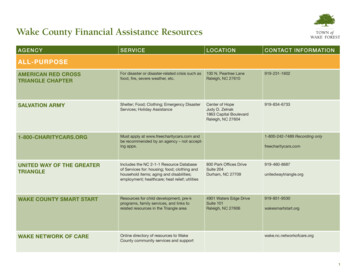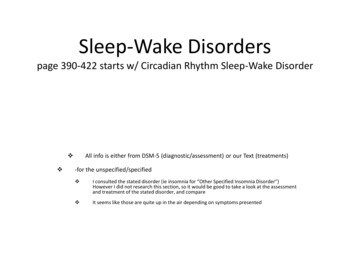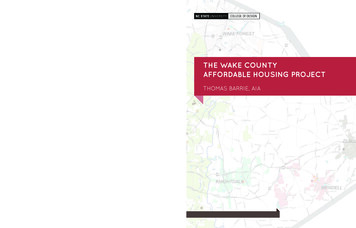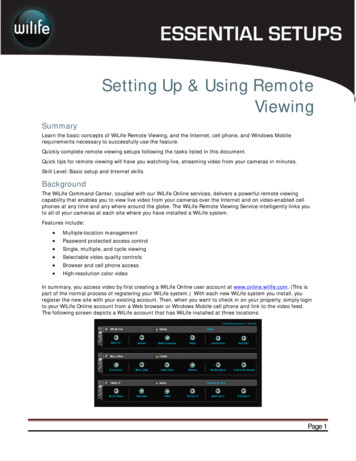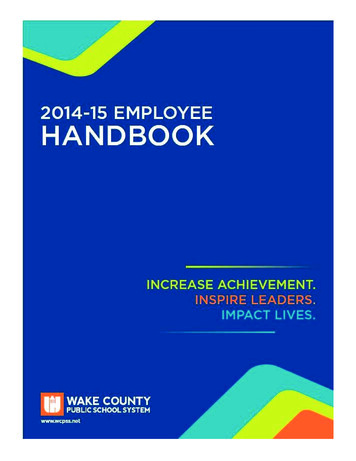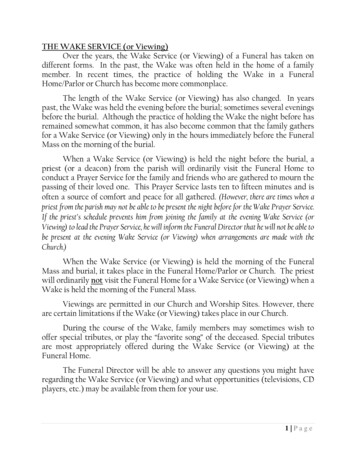
Transcription
THE WAKE SERVICE (or Viewing)Over the years, the Wake Service (or Viewing) of a Funeral has taken ondifferent forms. In the past, the Wake was often held in the home of a familymember. In recent times, the practice of holding the Wake in a FuneralHome/Parlor or Church has become more commonplace.The length of the Wake Service (or Viewing) has also changed. In yearspast, the Wake was held the evening before the burial; sometimes several eveningsbefore the burial. Although the practice of holding the Wake the night before hasremained somewhat common, it has also become common that the family gathersfor a Wake Service (or Viewing) only in the hours immediately before the FuneralMass on the morning of the burial.When a Wake Service (or Viewing) is held the night before the burial, apriest (or a deacon) from the parish will ordinarily visit the Funeral Home toconduct a Prayer Service for the family and friends who are gathered to mourn thepassing of their loved one. This Prayer Service lasts ten to fifteen minutes and isoften a source of comfort and peace for all gathered. (However, there are times when apriest from the parish may not be able to be present the night before for the Wake Prayer Service.If the priest’s schedule prevents him from joining the family at the evening Wake Service (orViewing) to lead the Prayer Service, he will inform the Funeral Director that he will not be able tobe present at the evening Wake Service (or Viewing) when arrangements are made with theChurch.)When the Wake Service (or Viewing) is held the morning of the FuneralMass and burial, it takes place in the Funeral Home/Parlor or Church. The priestwill ordinarily not visit the Funeral Home for a Wake Service (or Viewing) when aWake is held the morning of the Funeral Mass.Viewings are permitted in our Church and Worship Sites. However, thereare certain limitations if the Wake (or Viewing) takes place in our Church.During the course of the Wake, family members may sometimes wish tooffer special tributes, or play the “favorite song” of the deceased. Special tributesare most appropriately offered during the Wake Service (or Viewing) at theFuneral Home.The Funeral Director will be able to answer any questions you might haveregarding the Wake Service (or Viewing) and what opportunities (televisions, CDplayers, etc.) may be available from them for your use.1 Page
A EULOGYSometimes a family member or close friend of the deceased may wish to offera eulogy or words of remembrance.If a eulogy is to be delivered, it is most appropriately delivered at theFuneral Home, as the Wake Service (or Viewing) is coming to an end; at thegraveside, after the Committal Service has taken place; or at the luncheongathering after the burial.We kindly ask that eulogies, or words of remembrance, not be delivered inour Church before, during or after the Funeral Mass. If a family member(s) is trulydesirous about delivering a eulogy, the family should consider holding the Wake(or Viewing) in the Funeral Home, so the eulogy can be delivered as the Wake (orViewing) is coming to a close. A eulogy is also, very appropriately, offered at theluncheon which may follow the Funeral.THE FUNERAL MASSFor Catholics, the Mass is the highest, most intimate form of prayer that weoffer as a Church. It is by the Lord’s command that we gather to participate in theEucharist, and to pray for our deceased loved ones. We also pray for ourselves aswe begin a life without the physical presence of our deceased loved one. At thesame time, we take comfort in the hope offered to us by our faith in the Lord JesusChrist.A Funeral Mass differs in several ways from the usual Sunday Mass whichCatholics are more accustomed to attending. It remains the same, familiar Mass inmany other ways. Since members of other faiths, as well as members of our ownfaith, often gather together for the Funeral Mass, the priest takes special care toinvite everyone to sit, stand, or kneel at the appropriate parts of the Mass.The Introductory Rites of the MassAt the appropriate time, the Funeral Director will direct the family andfriends gathered at the Funeral Home to prepare to travel to the Church for theFuneral Mass with the Funeral procession.As the family and friends arrive at the Church, they follow the casketbearing the remains of their loved one into the Church. At a designated spot, thepriest will greet the family and begin the Mass.As part of the Introductory Rites, the priest will recall the moment ofBaptism of the deceased, and then sprinkle the casket with Holy Water.Immediately after the Sprinkling Rite, the Pall (a large white cloth symbolic of the2 Page
Baptismal garment first worn at Baptism) is placed on the casket. It is very appropriatefor family members to assist with the placing of the Pall on the casket, althoughthis is not required or mandatory.Once the Pall is placed on the casket, the priest will proceed to the Altar, asthe family and friends who have arrived with the Funeral procession make theirway to their seats, guided by the Funeral Director. Once the family arrives at theirpews, they should remain standing; the priest will lead all gathered in the OpeningPrayer of the Mass.Once the Opening Prayer is prayed, all are invited to be seated for theLiturgy of the Word.The Liturgy of the WordThe Liturgy of the Word follows the Opening Prayer. It consists of an OldTestament (“The First”) reading, a Responsorial Psalm (which is sung by theCantor), a New Testament (“The Second”) reading, a Gospel reading, the homilyand The Universal Prayer (The Prayer of the Faithful).(During the Easter Season {From Easter Monday to the Friday beforePentecost Sunday} a New Testament reading may be used as the FirstReading, as well as the Second Reading.)It is appropriate for family members or friends to participate in the FuneralMass as readers, although it is not required. (The same family member or friend may readboth the readings, or several members of the family may wish to do so.)If family members or friends read at the Funeral Mass, it is required thatthey be active, practicing members of our Catholic faith in good standing withthe Church. Members of other Christian faiths, or Catholics who are notcurrently active in our Catholic faith, should not be asked to read at theFuneral Mass.Family or friends reading at the Mass are asked to utilize the copies of theprescribed readings found in this packet to become familiar with any difficultwords.The reader is requested that he/she carry the enclosed copy of the readingwith them, and read from it during the proper time in the Liturgy of the Word.(The reader is asked to be familiar with the instructions which are written on the page ofeach reading in red at the top and bottom of the right side of the page.)Following the homily, all gathered pray The Universal Prayer, often times3 Page
call “The Prayer of the Faithful”. Again, it is appropriate for a family member toread the petitions of The Universal Prayer. (As is the case with the first and secondreadings, the reader of the Prayer of the Faithful must be an active member of the Catholic faith.)If a family member chooses to lead the Universal Prayer (The Prayer of theFaithful), he/she does so after the introductory prayer is prayed by the priest.After the Prayer of the Faithful, the Liturgy of the Eucharist follows.The Liturgy of the EucharistThe Liturgy of the Eucharist begins with the Presentation of the Giftsduring the Offertory Procession. If the family wishes, there can be two, three, orfour gifts in the Offertory Procession. (Only gifts of bread and wine may be presentedduring the Offertory Procession.) It is most appropriate that only active members ofour Catholic faith be asked to present the Gifts.When it comes time for the distribution of Holy Communion, the priest willinvite only those active members of our Catholic faith in good standing with theChurch to come forward to receive the Eucharist.The Church does not allow non-Catholics to receive the Eucharist, evenduring a time of mourning. Similarly, Catholics who are not properly disposed toreceive the Eucharist should refrain from reception of the Holy Eucharist, unlessthey have had the opportunity to avail themselves of the sacrament of Confessionprior to Mass. (The Guidelines for the reception of Holy Communion, as set forth by theCatholic Bishops of the United States, is included below for a convenient reference.)Guidelines for the Reception of Holy Communion,as set forth by the United States Conference of Catholic BishopsFOR CATHOLICSAs Catholics, we fully participate in the celebration of the Eucharist whenwe receive Holy Communion. We are encouraged to receive Communion devoutlyand frequently. In order to be properly disposed to receive Communion,participants should not be conscious of grave sin and normally should have fastedfor one hour. A person who is conscious of grave sin is not to receive the Body andBlood of the Lord without prior sacramental confession except for a grave reasonwhere there is no opportunity for confession. In this case, the person is to bemindful of the obligation to make an act of perfect contrition, including theintention of confessing as soon as possible (canon 916). A frequent reception of theSacrament of Penance is encouraged for all.4 Page
FOR OUR FELLOW CHRISTIANSWe welcome our fellow Christians to this celebration of the Eucharist asour brothers and sisters. We pray that our common baptism and the action of theHoly Spirit in this Eucharist will draw us closer to one another and begin to dispelthe sad divisions which separate us. We pray that these will lessen and finallydisappear, in keeping with Christ's prayer for us "that they may all be one" (Jn 17:21).Because Catholics believe that the celebration of the Eucharist is a sign ofthe reality of the oneness of faith, life, and worship, members of those churcheswith whom we are not yet fully united are ordinarily not admitted to HolyCommunion. Eucharistic sharing in exceptional circumstances by other Christiansrequires permission according to the directives of the diocesan bishop and theprovisions of canon law (canon 844 §4). Members of the Orthodox Churches, theAssyrian Church of the East, and the Polish National Catholic Church are urged torespect the discipline of their own Churches. According to Roman Catholicdiscipline, the Code of Canon Law does not object to the reception of Communionby Christians of these Churches (canon 844 §3).FOR THOSE NOT RECEIVING HOLY COMMUNIONAll who are not receiving Holy Communion are encouraged to express intheir hearts a prayerful desire for unity with the Lord Jesus and with one another.FOR NON-CHRISTIANSWe also welcome to this celebration those who do not share our faith inJesus Christ. While we cannot admit them to Holy Communion, we ask them tooffer their prayers for the peace and the unity of the human family.The Liturgy of the Eucharist continues, as usual, with the Prayer afterCommunion.The Final CommendationImmediately following the Prayer after Communion the priest will approachthe casket for the Final Commendation prayers. The family and friends remainstanding in their pews during these prayers.Once the prayers of Final Commendation are prayed, the Funeral Directorwill invite the family and friends to follow the casket out of the Church, as theyaccompany the casket to the cemetery.The Rite of Committal at the CemeteryImmediately following the prayers of Final Commendation, the family and5 Page
friends accompany the remains of their loved one for burial at the cemetery. TheFuneral Procession is guided by the Funeral Director. Family and friends, in theircars, follow behind the hearse to the cemetery.All those present at the cemetery for the Committal should be remindedthat the procession to the cemetery and the prayers at the cemetery are still a partof the Funeral Liturgy.At the cemetery, there is a short Committal Service to conclude the FuneralLiturgy which was begun in the Church. Once family and friends have paid theirfinal respects, they return to their cars. 6 Page
MUSIC DURING THE FUNERAL MASSMusic plays an integral part of the Liturgy; it lends beauty and solemnity tothe prayers of the worshipping community. Unless the family specifically requeststhat there be no music at the Funeral Mass, the parish, will arrange to have acantor and an organist present.Each Parish has a Director of Music. The Parish’s Director of LiturgicalMusic, or another member of our Parish’s Music Ministry, will call the familycontact (the family member whose name was supplied by the Funeral Director whenarrangements are made with the Church). The representative of our Music Ministry willdiscuss appropriate musical selections over the phone; they will also schedule aparish cantor for the Funeral Liturgy. (If the family wishes to request a specific parishcantor for the Funeral, they should express this desire when they speak to the representative fromour Parish Music Ministry.)If, in the unlikely event that someone from our Music Ministry does notmake contact with the family by 12 noon the day before the funeral, please call therespective rectory office to let us know, so that we may make the proper musicalarrangements for the Mass.The Cantor leads the congregation in song throughout the Mass. If thefamily desires specific hymns to be used during the Funeral Mass, we respectfullyask that only hymns particular to Catholic Worship be requested. That is to say,that no secular music may be used or played during the Funeral Mass. Asbeautiful as many songs are, and as seemingly appropriate as they might be,contemporary music and secular songs are not permitted to be used at any timeduring the Funeral Mass in Church.7 Page
Generally speaking, there are hymns needed for the following parts of the Mass.Please refer to the listing on the next page for suggestions of hymns for:-The Opening Hymn-The Hymn during the Preparation of the Gifts-The Hymn during the Communion Processional-The Post-Communion Meditation Hymn (this is an optional hymn)-The Recessional HymnMusic is also appropriate at the following times, but the selection of musicis limited to the prescriptions of the Church:-The Responsorial Psalm (The representative from our Music Ministry willdiscuss this selection with the family.)-The Gospel verse-The “Holy, Holy, Holy”-The Great Amen-The Lamb of God-The Hymn during the Final Commendation.Please see the listing of musical selections on the next page.This list is not meant to be exclusive or exhaustive; if you have hymns inmind that are not listed below (and which are appropriate for use in Catholic worship)please discuss them with the representative from our Parish Music Ministry whenthey contact the family.Although there are many acceptable hymns that may be used during aFuneral Mass, this listing is offered to suggest the hymns that are familiar in ourparish, that are appropriate for the Funeral Mass, or are hymns which are wellknown by many members of our faith.8 Page
HYMN SELECTIONS FOR THE FUNERAL MASSSelections for the Opening HymnAmazing Grace**Be Not Afraid**Blest Are TheyCome To Me**Faith of Our Fathers**Here I am, Lord**Selections for the Hymn during the Preparation of the GiftsAmazing Grace**Prayer of Saint FrancisBe Not Afraid**Seek Ye FirstHeart of Jesus**Soul of My Savior**I Have Loved YouSelections for the Hymn during the Communion ProcessionalCome To Me**O Sacrament Most HolyGift of Finest WheatO Salutaris HostiaHere I am, Lord**Shepherd of SoulsHeart of Jesus**Soul of My Savior**I Am The Bread of LifeTantum ErgoJesus, My Lord, My God, My AllWhere Charity and Love PrevailO Lord, I Am Not WorthySelections for the Post-Communion Meditation (This is an optional hymn)Ave MariaMary’s SongHail Mary, Gentle WomanSalve ReginaHeart of Jesus**Selections for the Recessional HymnBe Not Afraid**Faith of Our Fathers**Holy God, We Praise Thy NameHow Great Thou ArtI Know That My Redeemer LivesLet There Be Peace on EarthLift High The CrossMine Eyes Have Seen The GloryOn Eagles Wings**Indicates that the hymn may be used at different times in the Funeral Liturgy,however, it should not be used twice during the Funeral Mass.9 Page
THE INTERMENT OF THE FINAL REMAINSImmediate internment of the final remainsUnder ordinary circumstances, the remains of the deceased are borne inprocession to the final resting place in a nearby cemetery. It is highlyrecommended that family members traveling to the cemetery consolidate theirrides in order to reduce the number of cars that make up the Funeral Procession.It is the sincere attempt of the Funeral Director to travel at a speed that willaccommodate the procession remaining intact. However, an excessive number ofcars may make this effort extremely difficult, and sometimes dangerous.Once the procession has arrived at the cemetery, the Funeral Director willlead the gathered to the burial site for the Committal Service, usually conductedby a member of the clergy.Family and friends who have traveled with the procession should take careto remember that the Committal Service at the cemetery is still part of the FuneralLiturgy.Once the Committal Service is finished, the family and friends gathered willbe invited by the Funeral Director to step forward and offer their final respects.Once this is complete, family and friends return to their cars.If the burial is to take place at a cemetery distant from our area, the FuneralDirector may ask a member of the clergy located nearer to the cemetery to conductthe Committal Service prayers. If the burial is a great distance, or the burial isscheduled to take place the next day, arrangements will be made for a member ofthe clergy to meet the family to conduct the Committal Service at the cemetery.10 P a g e
CREMATIONIn November of 1996, the Vatican granted approval for the presence ofcremated remains, sometimes called cremated remains, to be brought into theChurch for a Funeral Mass. A Funeral Mass may take place before the cremation,or after cremation, depending on the preference of the family.There are various reasons why a family chooses cremation for their lovedone. It must be noted that cremation of the final remains of a baptized CatholicChristian is permitted by the Catholic Church.If the family chooses cremation before the burial, the Funeral Mass may bedelayed several days because of the time needed for the cremation process.If the family chooses cremation after the Funeral Mass, the burial of thecremated remains (of the deceased) may be delayed because of the time needed forthe cremation.In either case, it must be understood that Church regulations requirethat cremated remains be properly interred in a cemetery as soon as possibleafter the Funeral Mass is celebrated.The Archdiocese of Philadelphia offers the following Norms, in regardto cremation in the Archdiocese of Philadelphia:-The cremated remains are to be buried in a cemetery or entombed in amausoleum or columbarium;-It is not permitted to scatter cremated remains.-Likewise, it is not permitted to delay the burial/disposition of the crematedremains in anticipation of the eventual burial of another person.-The permanent storage of cremated remains in a private home, funeral home orany other place is prohibited.-The integrity of the cremated remains is always to be respected.-The cremated remains of one deceased person may not be mixed with thecremated remains of another person.-It is not permitted to divide the cremated remains and retain, inter or entombthem in more than one place.-It is also not permitted to divide the cremated remains in such a way thatthey are contained in lockets or jewelry.-Any other practice which violates the integrity of the cremated remains andimpedes reverent and proper burial/disposition is prohibited.-If burial takes place at sea, the cremated remains are to be in a solid anddurable container, and not scattered.11 P a g e
A Funeral Mass before the cremationIf the cremation is to take place after the Funeral Mass, the Funeral Masswould be held with the casket bearing the remains of the deceased present for theMass. Instead of accompanying the remains to the cemetery, the priest concludesthe Mass with a final blessing and the Funeral Liturgy comes to a formalconclusion at the Church.Once the cremation has taken place, the Funeral Director will contact theRectory to set a time convenient for the family and one of our priests will meet thefamily at the cemetery for the interment of the cremated remains.A Funeral Mass after the cremationIf the cremation takes place before the Funeral Mass, there are a few minorchanges that affect the Funeral Mass:-Family members are encouraged to carry the urn containing the crematedremains in procession into the Church and place it on a pre-positioned table,although this is not mandatory. (If a family member does not wish to carry the urn inprocession, the Funeral Director carries the urn into the Church.)-Unlike a Funeral Mass where the casket is present, no white Pall is placedon the urn. The Mass continues in the usual fashion. At the end of the FuneralMass, the urn is once again carried by a family member (or the Funeral Director) fromthe Church to the cemetery.At the cemetery, the Committal Service is held. Once the service iscompleted, family members return to the cars.If, for whatever the reason, the family wishes to delay the interment of thecremated remains until a later date and time, it is appropriate to wait for theFuneral Mass to take place so that the Mass and interment are one continuousevent.If there are no plans for burial of the cremated remains, this intentionand reason should be shared with the priest at the rectory in the earlieststages of the planning of the Funeral Liturgy.12 P a g e
OTHER POINTS OF INTERESTBagpipesSome people, because of their ethnic background, request that a bagpipeplayer be present at the Funeral. This request is honored in the following ways:-The Bagpipe player may greet the Funeral with a hymn at the door of theChurch when the procession arrives from the Funeral Home, and again greet therecessional procession with a song as the casket leaves the Church at the end ofthe Mass. It is not appropriate for the Bagpipe player to lead or accompany thecasket and family into the Church.-The bagpipe player, if time permits, may accompany the casket to thecemetery and play a hymn before and/or after the prayer service at the graveside iscompleted.-If time restraints are placed on the schedule of the Bagpipe player, it is mostappropriate to end the prayer service at the cemetery with bagpipes.A “Favorite” hymnOften times, a deceased loved one will be remembered because of a “favorite”hymn or song. If the hymn is a song written for Catholic liturgical use, it should beincorporated into the hymns of the Mass. If the hymn is not liturgical in nature,it may not be used during the Mass or in the Church.However, if the family is strongly in favor of the hymn being used, is it bestto play a recorded version of the song during the Wake in the Funeral Parlor, or, atthe graveside, after the prayers have been prayed, immediately before the familyand friends disperse. The luncheon gathering is another occasion when a favoritehymn can appropriately be played for all gathered.Family Members serving as Altar Servers at the Funeral MassIt sometimes occurs that grandchildren, nieces, nephews or children of thedeceased are Altar Servers (at our parish or in their home parish) and may wish to servethe Funeral Mass. Although this is permitted, it is, nonetheless, discouraged. At atime of death, children (especially) are not sure how to act. To separate them fromtheir parents or family members by letting them serve the Funeral Mass, oftenplaces an undue burden upon them. It is most appropriate that children stay closeto loved ones during a Funeral Mass.If it happens that they do want to serve the Mass, please inform the rectorybeforehand.13 P a g e
Guest Musicians or CantorsIt sometimes occurs that a family member or friend is musically talented andwish to offer their talent as part of the Funeral Mass. In an effort to preserve thesacred nature of the Liturgy, only persons who are currently active musicians orcantors in a Roman Catholic Parish are invited to join us as a guest musician or tocantor a Funeral Liturgy in our Parish.If a family member is currently a Cantor at their parish and they wish tocantor during the Funeral, please indicate this to our Parish Music Representativewhen they call to discuss musical selections.Effective September 1, 2016, families who wish to bring a guest musician infor the celebration of the Funeral Mass may do so; however, any guest musicians toour Parish (organist, harpist, bagpiper, etc.) must be professionally trained musicians.In addition, the family will be required to pay the prescribed Parish stipend for ourParish organist, who will be present for the liturgy. Guest musicians will bepermitted to play hymns during the Mass, however, our Parish organist will playthe Mass parts during the Funeral Liturgy. (For the sake of clarity, a ‘guest’ musician isany musician who is not on the payroll of our Parish.)Additionally, families are welcome to bring in an out-of-parish cantor;however, the family will be required to pay the prescribed Parish stipend for aParish cantor who will be assigned to sing at the Funeral Mass. During the FuneralMass, the guest cantor will be permitted to sing hymns, however, our Parishcantor will sing all the Mass parts during the Liturgy. (For the sake of clarity, a ‘guest’cantor is any cantor who is not a regular and active member of our Parish Music Ministry.)These decisions are being put in place primarily to respect the parishionersand employees who dedicate their time and talent on a regular basis to thisimportant ministry to our grieving families, while at the same time offeringfamilies, who may wish to do so, to exercise the option of bringing in additionalmusical accompaniment.Family Members assisting as Extraordinary Ministers of Holy CommunionIt may happen that a member of the family or close friend is anExtraordinary Minister of Holy Communion in their parish. Since they arecommissioned for their home parish, they may function as an ExtraordinaryMinster in their home parish only. Hence, exercising a ministry as anExtraordinary Minister at the Funeral Mass at our Parish is not possible.14 P a g e
If it happens that he/she is a current Extraordinary Minister of HolyCommunion at our Parish, he/she should speak with the priest before the Massbegins to ascertain if his or her services are needed for the distribution of HolyCommunion.Above all, family members should remember that these guidelines aredesigned to assist the family in the planning of the Funeral Mass.If any family member has questions or concerns after reading these guidelines,they are most welcome to speak with the Pastor.15 P a g e
Viewing) to lead the Prayer Service, he will inform the Funeral Director that he will not be able to be present at the evening Wake Service (or Viewing) when arrangements are made with the Church.) When the Wake Service (or Viewing) is held the morning of the Funeral Mass and burial, it takes place in the Funeral Home/Parlor or Church.



